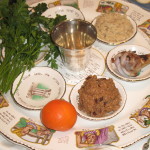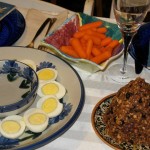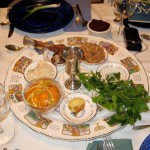 Passover is my holiday. For me, it’s the big one. Yes, Rosh HaShanah and Yom Kippur are big ones too – after all, I am a rabbi. And even though I’m not a congregational rabbi, I’ve had the privilege of leading an amazing and special congregation on the high holy days for the last 15 years, and I love that I get to do so. Sukkot and Shavuot are great too, of course, as are Chanukah and Purim and….
Passover is my holiday. For me, it’s the big one. Yes, Rosh HaShanah and Yom Kippur are big ones too – after all, I am a rabbi. And even though I’m not a congregational rabbi, I’ve had the privilege of leading an amazing and special congregation on the high holy days for the last 15 years, and I love that I get to do so. Sukkot and Shavuot are great too, of course, as are Chanukah and Purim and….
But Passover is my personal holiday. It’s about the home. It’s about the family. It’s about the story. And it’s about the food.
Passover has it all – slavery, degradation, trials, miracles, missteps, charismatic leaders, and eventually the triumph of liberation. Whether or not it contains actual historical truth – and that’s a question I’ll leave to the ongoing scholarly debate – it contains profound narrative truth. The ultimate truth of the Passover story is its power to bind the Jewish people together for generation after generation. The truth of Passover is its ongoing ability to teach us about continuity and survival, to impart the value of caring for the stranger, to call us to remember while pushing us forward toward the future, and to connect us to God. It is our defining story, the story that shapes us as a people.
When I first began to think about how Passover was to be observed in my own home as a young adult, I searched for ways to make it special. My motivation at the time was admittedly more parental than spiritual. I wanted to create an approach to Passover that would make my children feel special rather than restricted. I wanted to create rich and meaningful memories for them. And I wanted to create something that was unique to who we were as a family.
I grew up with seders that were fun and delicious. There were readings from our minimalist haggadah that were especially beloved by different family members – my  mother lighting the holiday candles, my grandmother carefully enunciating the words of the Ten Plagues, my father particularly drawn to the Edmond Fleg reading “I am a Jew because…” And of course who didn’t love searching for the afikoman and getting a silver dollar from my father? The rituals of the seder shared the spotlight with the food, which emerged from the kitchen in slow stages over the course of the long evening, each with its own meaning and history.
mother lighting the holiday candles, my grandmother carefully enunciating the words of the Ten Plagues, my father particularly drawn to the Edmond Fleg reading “I am a Jew because…” And of course who didn’t love searching for the afikoman and getting a silver dollar from my father? The rituals of the seder shared the spotlight with the food, which emerged from the kitchen in slow stages over the course of the long evening, each with its own meaning and history.
Later I encountered different kinds of seders: a Hillel seder in college which was tremendous fun despite the mediocre food shipped in from a kosher caterer across the state, a hundred college students drinking unlimited amounts of cheap kosher wine; a kibbutz seder held in the vast communal dining room, in which corn and rice held places of prominence on the table, the seder leader used a microphone, and the focus of the haggadah was on agriculture; a seder with my Moroccan flatmate’s family in Hadera featuring tumeric-yellow piquant fish in a spicy tomato sauce instead of gefilte fish, and many unfamiliar songs to which I could not sing along; a seder with ex-South Africans in Ra’anana with many little cousins spilling bottles of coke across the white tablecloths and an Elijah who miraculously showed up at the door demanding wine.
What’s evolved over the years at our home is a second night seder that I think of as our big annual performance art piece (I went to art school before I went to
rabbinic school). I don’t mean that the seder is merely a performance put on for an audience, but rather that it’s meant to be a participatory experience in which all senses of those gathered around are fully engaged. This is art created as interpretation of the Passover story, art that is meant to be lived and tasted and felt in the gut, an extension of what our tradition brilliantly began by imbuing certain seder foods like charoset with narrative meaning. It’s the four questions writ large – we eat this because…
Our seder involves weeks of planning and preparation. It is the one time of year that my secret inner Martha Stewart comes out. I have lists and charts and know what has to get done on what day in the weeks leading up to the seder. I track which ingredients have to be bought when, and from where; which dishes can be made two or three weeks ahead and frozen, and which need to be made fresh right ahead of time. It’s the one time a year that I can indulge in being the balabusta I don’t have the time or inclination to be the rest of the year.
The laws of Passover are important. Reading the Haggadah is important. But the real lessons of Passover in our home are food-based. Each food tells its own part of the collective story. The tastes, the smells, the colors, the textures are all important elements of shinantem l’vanecha – teaching our children what it means to be part of the Jewish people, part of chain of tradition that reaches back farther than we can see.
 Much of this is centered around the food, but it’s not just about the food. And this is not just an update on my mother’s Askenazi lineup of greatest hits. A menu has evolved, with small annual tweaks, that draws on my family’s history, my personal history, and Jewish history. And it’s more than the food – there are tables and chairs to order. There’s the “eating down of the freezer” to make room in the weeks leading up to Passover. There’s cleaning the cabinets and storing the chametz and getting out the special pesadik dishes. And the guest list – who’s coming back from prior years? How many new people do we have room to include? There are tablecloths to clean and flowers to buy and silver to polish….
Much of this is centered around the food, but it’s not just about the food. And this is not just an update on my mother’s Askenazi lineup of greatest hits. A menu has evolved, with small annual tweaks, that draws on my family’s history, my personal history, and Jewish history. And it’s more than the food – there are tables and chairs to order. There’s the “eating down of the freezer” to make room in the weeks leading up to Passover. There’s cleaning the cabinets and storing the chametz and getting out the special pesadik dishes. And the guest list – who’s coming back from prior years? How many new people do we have room to include? There are tablecloths to clean and flowers to buy and silver to polish….
All of which sounds extremely mundane. Yet it’s very spiritual, even the lists. The making of order out of chaos, the cycle of the preparations, the turning back around to hope and liberation, the coming out from winter into spring, checking last year’s menus and guest lists and making updates while remembering seders past and former guests no longer in this world – all of this speaks of our ongoing story, of the importance of memory, of our ongoing survival and adaption and interpretation. The extensive planning and preparing and cooking aren’t ends unto themselves, but a way to participate in the constantly unfolding miracle of the ongoing story.

